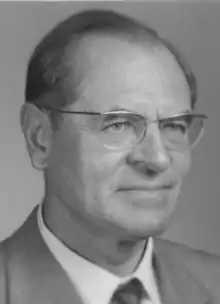Herbert Mataré
Herbert Franz Mataré (22 September 1912 – 2 September 2011[1]) was a German physicist. The focus of his research was the field of semiconductor research. His best-known work is the first functional "European" transistor, which he developed and patented together with Heinrich Welker in the vicinity of Paris in 1948, at the same time and independently from the Bell Labs engineers. The final 20 years of his life Mataré split time between his homes in Hückelhoven, Germany and Malibu, California. Born in Aachen.

Biography
Mataré completed his studies in mathematics, chemistry, electrochemistry, nuclear physics and solid-state physics at the Technical University of Aachen with degree "Diplom-Ingenieur" in Applied Physics. In addition, he studied mathematics, physics and chemistry at the University of Geneva.[2]
In 1939 he joined the Telefunken research laboratory in Berlin. At that time it became obvious that the miniaturization of vacuum tubes had met a technical limit and that alternative solutions had to be sought using solid state circuits and principles of the previous transistor inventions of Julius Edgar Lilienfeld, Oskar Heil, Walter Schottky and Robert Wichard Pohl.
Because of the massive air raids on Berlin in 1943, the Telefunken laboratory were moved to the Cisterian abbey in Lubiąż (Leubus) Silesia, where Mataré focused on the improvement of the cm-wave (SHF) receiver sensitivity.
In 1944, as the Russian army closed in, the site and most of its equipment were abandoned and the operation was transferred to Thuringia. Later Mataré taught physics and mathematics in Wabern near Kassel and gave lectures at the Aachen university, and he was invited to build a semiconductor diode plant for Compagnie des Freins & Signaux Westinghouse in Aulnay-sous-Bois near Paris.

Academic degrees
| 1933 | BS | Physics, Mathematics, and Chemistry | Aachen; University of Geneva |
| 1939 | MS (Dipl.-Ing.) | Physics | Technische Hochschule Aachen |
| 1942 | PhD (Dr.-Ing.) | Electronics | Technische Hochschule Berlin |
| 1950 | PhD (Dr. sc. phys) | Solid State Physics | École Normale Supérieure (ENS) Paris |
Important Work
At the same time as the American researchers and independently, the German researchers Mataré and Heinrich Welker developed the first operational "French transistor" at Compagnie des Freins & Signaux Westinghouse in Aulnay-sous-Bois near Paris during the years 1945 to 1948. They filed their first transistor patent application on 13 August 1948.[3][4] On 18 May 1949, this European invention coined as the "Le Transistron" was presented to the public.
In 1951/1952, Mataré founded Intermetall in Düsseldorf, the world's first company which offered diodes and transistors.[2]
Awards (selection)
- „Life Fellow IEEE“
- „Member emeritus“ New York Academy of Sciences
- Eduard Rhein Ring of Honor, Eduard Rhein Foundation, 2008.[5][6]
Literature
- H. F. Mataré (April 2001). "Erlebnisse eines deutschen Physikers und Ingenieurs von 1912 bis Ende des Jahrhunderts". Der Fernmelde-Ingenieur. 4/01, 5/01 (in one volume): 1–109. ISSN 0015-010X.
- H. F. Mataré (September 2002). "Von der Radartechnik zur modernen Kommunikationstechnik". Tele-Kommunikation aktuell: TKA. 9/02, 10/02 (in one volume): 1–59. ISSN 1619-2036.
- Kai Handel (1999-06-29). "Anfänge der Halbleiterforschung und -entwicklung. Dargestellt an den Biographien von vier deutschen Halbleiterpionieren" (PDF). PHD Thesis RWTH Aachen. Archived from the original (PDF) on 2008-10-30. Retrieved 2008-10-12.
- Armand Van Dormael (2009). "Biographies: Herbert F. Mataré". IEEE Annals of the History of Computing. 31 (3): 68–73. doi:10.1109/MAHC.2009.38.
Patents
The following list can only present a part of the more than 80 patents which Mataré has filed.
- US 2552052 H. F. Mataré: „Push-pull converter of the crystal type for ultra-short waves“ filed in France on May 23, 1947
- FR 1010427 H. F. Mataré/H. Welker/Westinghouse: „Nouveau système cristallin à plusieurs électrodes réalisant des effects de relais électroniques“ filed on August 13, 1948
- US 2673948 H. F. Mataré/H. Welker/Westinghouse: „Crystal device for controlling electric currents by means of a solid semiconductor“ french priority date August 13, 1948
Controversial views
Mataré contributed articles to the controversial journal Mankind Quarterly. In his book Conscientious Evolution (1982) he discussed a broad range of topics including genetic engineering, eugenic measures, controlled procreation, sterilization and capital punishment. Matare's ill-advised articles and text were poorly formulated and lacking in scientific basis. The anthropologist H. James Birx described the book as deeply prejudiced, "neither a careful examination of the promise of human genetics nor a contribution to the science of organic evolution."[7]
References
- The Wikimedia Support Team has a scan of Mataré's obituary under Ticket:2011092210019198
- Armand Van Dormael:The "French" transistor., at cdvandt.org, retrieved 22-09-2013
- FR 1010427 H. F. Mataré / H. Welker / Westinghouse: "Nouveau sytème cristallin à plusieurs électrodes réalisant des relais de effects électroniques" filed on August 13, 1948
- US 2673948 H. F. Mataré / H. Welker / Westinghouse, "Crystal device for controlling electric currents by means of a solid semiconductor" French priority August 13, 1948
- DIE WELT ONLINE „Der deutsche Erfinder des Transistors“ November 14, 2008
- "The Eduard Rhein Ring of Honor Recipients". Eduard Rhein Foundation. Archived from the original on July 18, 2011. Retrieved February 5, 2011.
- Birx, James H. (1984). Neo-Darwinism and Neo-Social Darwinism. The Great Evolution Mystery by Gordon Rattray Taylor; Conscientious Evolution by Herbert F. Mataré. BioScience 34: 196-197.
External links
- Herbert Mataré in the German National Library catalogue
- Peter Salomon: „Deutsche Halbleiter-Technik vor 1945 ?“
- John Markoff (February 24, 2003). "Herbert F. Mataré. An inventor of the transistor has his moment". New York Times. Archived from the original on June 23, 2009.
- Michael Riordan (November 2005). "How Europe Missed The Transistor". IEEE Spectrum. 42 (11): 52–57. doi:10.1109/MSPEC.2005.1526906. Archived from the original on 2008-02-14.
- Armand van Dormael: "The „french“ transistor" at cdvandt.org, retrieved 22-09-2013
- Konrad Lischka (April 17, 2008). "60 JAHRE EURO-TRANSISTOR: Deutschlands vergessene Chip-Großväter". SPIEGEL Online.